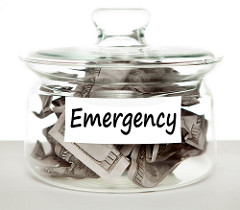
Photo by Tax Credits 
Here’s an easy way to determine the minimum size of your emergency fund. It is a quick and dirty way that should stand you in good stead.
The purpose of an emergency fund is to have money available in case of unexpected expenses. By dipping into the emergency fund to pay them, you don’t have to rely on high-cost credit card debt. Rather, you can use your emergency fund and then replenish it to its ideal level.
Traditional Emergency Fund Size
Traditional financial advice suggests you have three-to-six months of your living expenses in liquid assets. Usually this advice means cash in a savings account.
So what expenses do you need to include? Include those expenses that you would have to pay each month if, for example, you lost your job. Using this example, it would include housing costs, debt payments, as well as living expenses (food, entertainment, and fixed expenses such as insurance payments and utility bills).
Alternative Emergency Fund Size Calculation
Another approach to calculate your emergency fund size uses a bottom-up approach that looks at the causes of emergency spending. Emergency spending usually comes in these five circumstances:
- You have a health emergency and need medical or dental care,
- You have an auto accident and need to repair your car,
- You have damage to your home (or thefts) and need to fix it,
- Your home needs a sudden repair (broken furnace, leaky pipes, new A/C system),
- Your pet needs medical care.
The first three expenses are insurable. Your insurer should pay for the loss after you’ve paid your deductible. The quick and dirty way to calculate your emergency fund size is to add up the deductible amounts on your health, auto, and homeowner’s policies. I also like to add in at least a $1,000 for unexpected dental work. Crowns aren’t cheap and usually not 100% covered by dental insurance.
If your home is new, home repairs may be minimal. But include more if your home is older and in need of repairs. Of course, if you rent, no need to include this category in your emergency fund calculation. And if you have a pet, please add additional money for pet health care costs. Finally, if your car is older include money in the emergency fund for unexpected repairs.
For example, if your health care deductible is $3,000, auto deductible is $500, and your homeowners’ deductible is $2,500, your emergency fund should be at least $6,000. You may want to add in $1,500 for unexpected dental costs and $2,000 for unexpected car repairs.
And if you want to be extra cautious about unexpected health costs, use your health insurance policy’s out-of-pocket maximum rather than the deductible. This amount is the most your will spend in one year on health services covered by your policy. It includes not only the deductible but any copays or coinsurance amounts for services actually used. So in the example above, if you want to be cautious use the health out-of-pocket maximum instead of the deductible.
Remember you can count your Health Savings Account (HSA) as part of your emergency fund. It would certainly be drawn upon to offset unexpected health costs.
Lastly, this approach is best used for those with steady income. If your income is variable or your job is not certain, consider increasing the size of your emergency fund to cover additional living expenses.
Using Your Emergency Fund
The other important thing after setting the emergency fund size is to have a plan to replenish it if you draw upon it. For example, if you have to spend that $800 for a new crown, how are you going to get the $800 back in the fund? Often the best way is to divert some of your paycheck (e.g., $75/paycheck) automatically to your emergency fund.
My point is that you should have a replenishment plan in place prior to drawing on the fund. This way you don’t have to worry about the fund being depleted in case it is used.
In sum, use the potential sources of emergency spending to help you figure out the right emergency fund size. And once you have it, make sure you have a plan in place to replenish your emergency fund should you need it.

No comments yet.